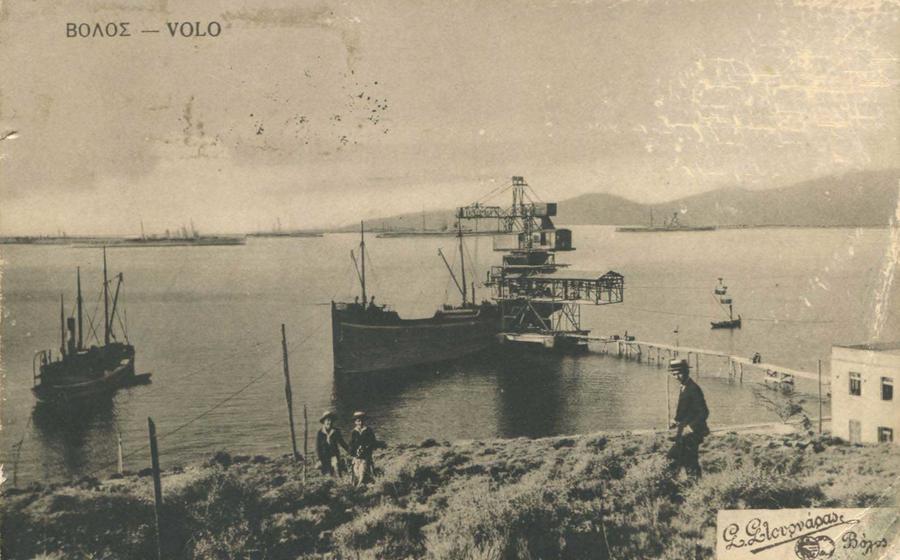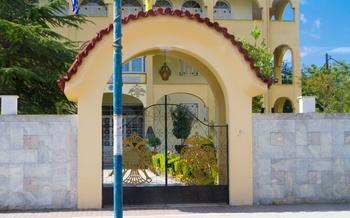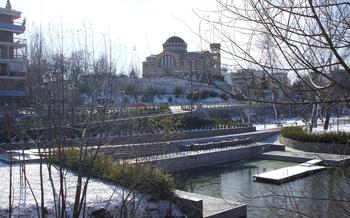
Path of the Centaurs
- Volos, the Gateway to Mount Pelion and the Centaur Trail
- The Legend of the Centaurs
- Exploring the Path of the Centaurs
- Natural Wonders of the Path
- The Centaur's Cave
- The Village of Makrinitsa
- The Monasteries of Mount Pelion
- Local Cuisine and Gastronomic Delights
- The Port of Volos and its Maritime Charm
- The Archaeological Museum of Volos: A Journey Through History
- Outdoor Activities and Adventure
- Festivals and Cultural Events
- Day Trips from Volos: Unveiling Hidden Gems
- Insider Tip:
Volos, the Gateway to Mount Pelion and the Centaur Trail
Situated on the eastern coast of Greece, Volos is a vibrant city with a rich history and a strategic location as the gateway to the mythical Mount Pelion. The city is deeply intertwined with the legend of Jason and the Argonauts, who set sail from Volos on their epic quest for the Golden Fleece. The region boasts breathtaking landscapes, from the lush forests of Mount Pelion to the crystal-clear waters of the Pagasetic Gulf, creating a harmonious blend of natural beauty and historical significance. As you explore Volos, you'll uncover a tapestry of ancient myths, cultural treasures, and outdoor adventures, making it an ideal destination for travelers seeking an immersive and enchanting experience.
The Legend of the Centaurs
In the realm of Greek mythology, the Centaurs hold a captivating place, their origins shrouded in mystery and wonder. These mythical creatures, half-human and half-horse, are deeply intertwined with the enchanted forests of Mount Pelion, where they roamed freely and left an indelible mark on the region's folklore.
The Centaurs are said to have been born from the union of Ixion, a mortal king, and Nephele, a cloud nymph. Their dual nature reflected their wild and untamed spirit, capable of both great wisdom and impulsive actions. Chiron, the most renowned Centaur, stood apart from his brethren, known for his exceptional intelligence and healing abilities.
In Greek mythology, the Centaurs played pivotal roles in various tales. They served as mentors and teachers to renowned heroes like Achilles and Jason, guiding them on their perilous quests. However, their untamed nature often led to conflicts, most notably the battle with the Lapiths, a neighboring tribe, which resulted in the Centaurs' eventual retreat to the seclusion of Mount Pelion.
Artistic depictions of Centaurs can be found throughout Greek art and literature, showcasing their diverse and complex nature. From the majestic sculptures of the Parthenon to the vivid descriptions in Homer's Iliad and Odyssey, the Centaurs remain an enduring symbol of the untamed wilderness and the duality of human nature.
Exploring the Path of the Centaurs
The Path of the Centaurs, also known as the Centaur Trail, is a captivating hiking trail that winds its way through the enchanting landscapes of Mount Pelion, the mythical abode of the Centaurs. This well-marked trail offers an immersive experience into the heart of Greek mythology, history, and natural beauty.
The trail typically begins in the charming village of Agios Ioannis, nestled at the foot of Mount Pelion. From here, hikers embark on a journey through diverse terrain, traversing lush forests, crossing crystal-clear streams, and ascending to panoramic viewpoints. The duration of the hike can vary depending on the chosen route, ranging from a leisurely day hike to a challenging multi-day trek.
The difficulty level of the trail ranges from easy to moderate, making it accessible to hikers of varying abilities. The well-maintained paths are suitable for both experienced hikers and those seeking a more relaxed adventure. Along the way, hikers are rewarded with breathtaking vistas of the Aegean Sea, the Pagasetic Gulf, and the surrounding mountains.
Natural Wonders of the Path
The Path of the Centaurs is a treasure trove of natural wonders, offering a feast for the eyes and a sense of tranquility for the soul. As you traverse the trail, you'll be enveloped by lush forests, teeming with a diverse array of flora. From towering oaks and pines to fragrant wildflowers and cascading ferns, the vegetation along the path is a testament to the region's rich biodiversity.
Along the way, you'll be rewarded with panoramic views of the Aegean Sea, stretching out before you in all its cerulean glory. The sparkling waters, dotted with idyllic islands, create a breathtaking backdrop for your journey.
Majestic waterfalls and crystal-clear streams add to the allure of the path. The sound of rushing water, echoing through the forest, creates a symphony of nature that soothes the senses and invites you to linger in the moment.
Finally, keep an eye out for unique rock formations and hidden caves that dot the landscape. These geological wonders, shaped by eons of wind, water, and seismic activity, offer a glimpse into the earth's rich history and provide opportunities for exploration and adventure.
The Centaur's Cave
Deep within the heart of Mount Pelion lies a mystical and awe-inspiring place known as the Centaur's Cave. This legendary grotto holds a profound significance in Greek mythology, believed to be the dwelling place of Chiron, the wise and benevolent Centaur. According to ancient tales, Chiron was a skilled healer and teacher, imparting knowledge and wisdom to many heroes, including Jason, Achilles, and Hercules.
Archaeological excavations within the cave have unearthed fascinating artifacts, shedding light on its historical and cultural importance. Discoveries include ancient pottery, tools, and remnants of religious rituals, offering glimpses into the lives of those who once inhabited this sacred space.
Beyond its mythological and archaeological significance, the Centaur's Cave exudes a palpable spiritual and mystical atmosphere. Visitors are often drawn to its tranquil ambiance, seeking solace and inspiration amidst the serene surroundings. The cave's acoustics create a unique resonance, amplifying the sound of dripping water and distant whispers, adding to its mystical charm.
The Village of Makrinitsa
Nestled amidst the verdant slopes of Mount Pelion, the picturesque village of Makrinitsa enchants visitors with its traditional architecture, cobblestone streets, and breathtaking views of the Pagasetic Gulf. Wander through its charming alleys adorned with colorful flowers and admire the well-preserved stone houses, each a testament to the village's rich history.
For a truly immersive experience, indulge in the local culinary delights at one of the many tavernas, savoring traditional dishes prepared with fresh, local ingredients. Don't miss the opportunity to sample the village's renowned spoon sweets, a unique confection made from fruits, nuts, and spices, a testament to the region's culinary heritage.
Makrinitsa is also a treasure trove of local crafts, where artisans create intricate embroideries, woven textiles, and ceramic pieces. Take home a piece of this artistic legacy as a cherished memento of your visit to this enchanting village.
History buffs will appreciate the village's historical landmarks, including the Church of Agios Ioannis Prodromos, with its impressive iconostasis and frescoes, and the Folklore Museum, which showcases the village's rich cultural traditions.
As the sun begins to set, find a spot to witness the magical spectacle of the sunset over the Pagasetic Gulf. The sky transforms into a canvas of vibrant hues, casting a golden glow on the village and the surrounding landscape, creating a moment of pure serenity and awe.
The Monasteries of Mount Pelion
Nestled amidst the verdant slopes of Mount Pelion, a cluster of ancient monasteries stands as a testament to the region's rich religious and cultural heritage. These sacred sanctuaries, some dating back to the 10th century, offer a unique blend of architectural beauty, historical significance, and spiritual tranquility.
The Monastery of Saint John the Baptist (Moni Agiou Ioannou Prodromou) is a prime example of Byzantine monastic architecture, with its intricate frescoes and stunning views over the Pagasetic Gulf. The Holy Monastery of the Annunciation of the Theotokos (Moni tis Panagias tis Annonciation) is renowned for its impressive library and collection of rare manuscripts. The Monastery of Saint Nicholas (Moni Agiou Nikolaou), perched on a hilltop overlooking Volos, offers breathtaking panoramic vistas.
Beyond their religious significance, these monasteries also hold cultural and historical treasures. They have served as centers of learning, preserving ancient texts and fostering the arts. Their walls are adorned with exquisite frescoes, depicting scenes from the Bible and the lives of the saints, offering a glimpse into the region's artistic heritage.
For those seeking spiritual reflection and a deeper connection with the divine, the monasteries of Mount Pelion provide an ideal setting. Their serene atmosphere, surrounded by nature's beauty, invites contemplation and inner peace. Visitors are welcome to attend religious services, participate in guided tours, or simply bask in the tranquility of these sacred spaces.
Local Cuisine and Gastronomic Delights
Volos and Mount Pelion are renowned for their culinary treasures, offering a delectable blend of traditional Greek flavors and local specialties.
Fresh seafood takes center stage, with an array of grilled fish, succulent shrimp, and mouthwatering calamari gracing the menus of tavernas along the coast. The region's fertile valleys yield an abundance of fresh produce, inspiring dishes bursting with vibrant colors and flavors.
Olive oil, a liquid gold of the Mediterranean, is a staple in Pelion's cuisine, adding a rich, fruity flavor to everything from salads to stews. Local cheeses, crafted with care from sheep and goat milk, offer a variety of textures and flavors, perfect for savoring with a glass of local wine.
Honey, another local delicacy, is produced in abundance on the slopes of Mount Pelion. Its sweet, golden nectar adds a touch of sweetness to traditional desserts like baklava and kataifi, tantalizing the taste buds with every bite.
For those seeking a truly immersive culinary experience, cooking classes and workshops are available, offering hands-on opportunities to learn the secrets behind Pelion's beloved dishes.
The Port of Volos and its Maritime Charm
The port of Volos is a vibrant hub of activity, where the city's maritime heritage comes alive. Stroll along the picturesque waterfront promenade, lined with charming cafes, restaurants, and shops, and soak in the lively atmosphere. Admire the majestic Argonaut Statue, a symbol of the city's connection to the legendary voyage of Jason and the Argonauts.
Hop on a boat trip to explore the nearby islands and secluded beaches that dot the Pagasetic Gulf. Discover hidden coves, swim in crystal-clear waters, and bask in the Mediterranean sun. For those seeking adventure, indulge in nautical activities like sailing, fishing, or kayaking, and experience the thrill of navigating the beautiful coastline.
The Archaeological Museum of Volos: A Journey Through History
Nestled in the heart of Volos, the Archaeological Museum stands as a testament to the region's rich cultural heritage. Step inside and embark on a journey through time, where ancient artifacts and fascinating exhibits narrate the story of Volos and its surroundings.
Discover the treasures of Neolithic settlements, marvel at prehistoric finds that shed light on early human civilizations, and trace the evolution of Volos from its humble beginnings to its emergence as a thriving port city.
Immerse yourself in the history of the region as you explore exhibits dedicated to local customs, traditions, and daily life. Learn about the maritime heritage of Volos, its role in trade and commerce, and the significant impact it had on the development of the city.
The Archaeological Museum of Volos is not just a repository of artifacts but a gateway to understanding the cultural tapestry of this captivating region. Its collection provides valuable insights into the past, enriching your appreciation for the present-day wonders of Volos and Mount Pelion.
Outdoor Activities and Adventure
Volos and Mount Pelion offer a plethora of outdoor activities for adventure enthusiasts. For those who love to explore on foot, numerous hiking and mountain biking trails wind through the picturesque landscapes, offering breathtaking views and encounters with nature. The Path of the Centaurs is a must-do for hikers, traversing lush forests, crossing sparkling streams, and leading to hidden waterfalls. For a unique perspective, horseback riding excursions allow visitors to traverse the mountain trails while connecting with these majestic animals.
The crystal-clear waters of the Aegean Sea and Pagasetic Gulf invite water sports enthusiasts to indulge in kayaking, paddleboarding, and other aquatic adventures. Several organized tours and guided adventures are available, catering to different skill levels and interests, ensuring an unforgettable experience in the natural wonders of the region.
Festivals and Cultural Events
Volos and Mount Pelion come alive with a vibrant calendar of festivals and cultural events throughout the year, offering visitors a chance to immerse themselves in the rich traditions and heritage of the region.
-
The highlight is the annual Centauromachia festival, held in August in the village of Makrinitsa. This three-day extravaganza celebrates the mythical battle between the Centaurs and the Lapiths, featuring theatrical performances, traditional music and dance, and a grand procession through the village streets.
-
Throughout the summer months, various villages host traditional Greek dancing and music performances, where visitors can join in the lively festivities and learn about the region's rich cultural heritage.
-
Local fairs and markets are held regularly, showcasing local crafts, culinary delights, and agricultural products, providing an opportunity to interact with the friendly locals and experience the authentic charm of Greek village life.
Day Trips from Volos: Unveiling Hidden Gems
Volos serves as an ideal base to explore the surrounding region, offering a plethora of day trip options to diverse destinations. Explore the picturesque towns of Portaria and Milies, nestled amidst lush greenery with stunning views of the Pagasetic Gulf. Discover the awe-inspiring Meteora monasteries, perched atop colossal rock formations, a UNESCO World Heritage Site that exudes an ethereal ambiance. Embark on a boat trip to the Sporades islands, a cluster of idyllic islands with pristine beaches, secluded coves, and charming villages. Each destination offers its unique allure, inviting you to delve deeper into the natural and cultural wonders of this captivating region.
Insider Tip:
-
Best time to visit: Spring (March-May) and autumn (September-October) offer ideal weather for hiking and exploring the region. Summer (June-August) can be hot and crowded, while winter (November-February) brings unpredictable weather conditions.
-
Accommodation: Volos offers a range of accommodation options, from budget hostels to charming guesthouses and luxurious hotels. For a unique experience, consider staying in a traditional stone-built cottage in one of the picturesque villages of Mount Pelion.
-
Local customs and etiquette: Respect local traditions and customs. Dress modestly when visiting monasteries and churches. Greet people with a smile and a friendly "kalimera" (good morning/afternoon). Tipping is customary in restaurants and for services like taxis and guided tours.
-
Packing essentials: Pack comfortable hiking shoes, layers of clothing for changing weather conditions, a hat, sunscreen, and a refillable water bottle. Bring a camera to capture the stunning scenery and consider binoculars for wildlife spotting.









